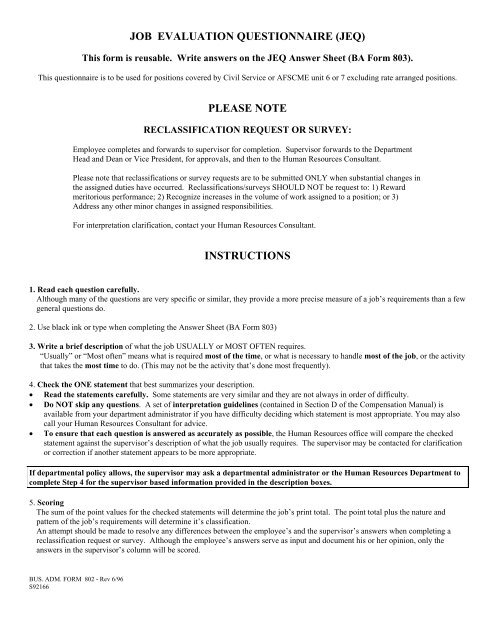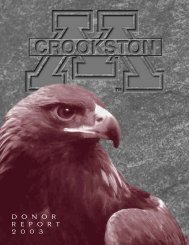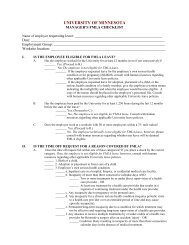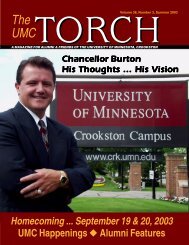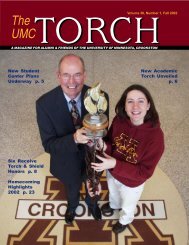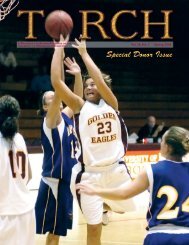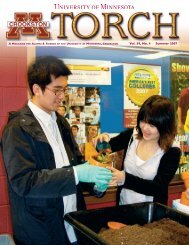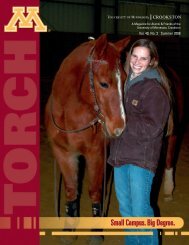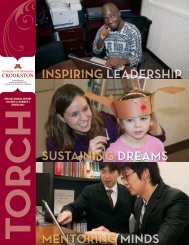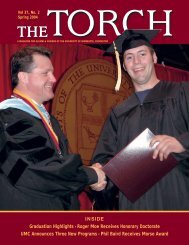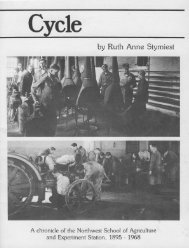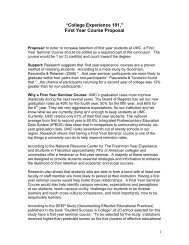Job Evaluation Questionnaire (JEQ)
Job Evaluation Questionnaire (JEQ)
Job Evaluation Questionnaire (JEQ)
You also want an ePaper? Increase the reach of your titles
YUMPU automatically turns print PDFs into web optimized ePapers that Google loves.
JOB EVALUATION QUESTIONNAIRE (<strong>JEQ</strong>)This form is reusable. Write answers on the <strong>JEQ</strong> Answer Sheet (BA Form 803).This questionnaire is to be used for positions covered by Civil Service or AFSCME unit 6 or 7 excluding rate arranged positions.PLEASE NOTERECLASSIFICATION REQUEST OR SURVEY:Employee completes and forwards to supervisor for completion. Supervisor forwards to the DepartmentHead and Dean or Vice President, for approvals, and then to the Human Resources Consultant.Please note that reclassifications or survey requests are to be submitted ONLY when substantial changes inthe assigned duties have occurred. Reclassifications/surveys SHOULD NOT be request to: 1) Rewardmeritorious performance; 2) Recognize increases in the volume of work assigned to a position; or 3)Address any other minor changes in assigned responsibilities.For interpretation clarification, contact your Human Resources Consultant.INSTRUCTIONS1. Read each question carefully.Although many of the questions are very specific or similar, they provide a more precise measure of a job’s requirements than a fewgeneral questions do.2. Use black ink or type when completing the Answer Sheet (BA Form 803)3. Write a brief description of what the job USUALLY or MOST OFTEN requires.“Usually” or “Most often” means what is required most of the time, or what is necessary to handle most of the job, or the activitythat takes the most time to do. (This may not be the activity that’s done most frequently).4. Check the ONE statement that best summarizes your description.• Read the statements carefully. Some statements are very similar and they are not always in order of difficulty.• Do NOT skip any questions. A set of interpretation guidelines (contained in Section D of the Compensation Manual) isavailable from your department administrator if you have difficulty deciding which statement is most appropriate. You may alsocall your Human Resources Consultant for advice.• To ensure that each question is answered as accurately as possible, the Human Resources office will compare the checkedstatement against the supervisor’s description of what the job usually requires. The supervisor may be contacted for clarificationor correction if another statement appears to be more appropriate.If departmental policy allows, the supervisor may ask a departmental administrator or the Human Resources Department tocomplete Step 4 for the supervisor based information provided in the description boxes.5. ScoringThe sum of the point values for the checked statements will determine the job’s print total. The point total plus the nature andpattern of the job’s requirements will determine it’s classification.An attempt should be made to resolve any differences between the employee’s and the supervisor’s answers when completing areclassification request or survey. Although the employee’s answers serve as input and document his or her opinion, only theanswers in the supervisor’s column will be scored.BUS. ADM. FORM 802 - Rev 6/96S92166
SKILLThis section measures the amount of skill required for working with machines, plants or animals, working with data, working withpeople using standard English and a technical or foreign language and writing in standard English and a technical or foreign language.The impact of these skills is measured by the size of the work unit affected and by the consequences of possible errors. These impactquestions seem repetitious but it’s important to answer each one separately according to the skill mentioned. Do NOT write “seeprevious answer” since each skill may have a different impact.Skill with Machines, Plants and Animals1. What skill at working with machines, plants or animals is MOST OFTEN required of this position?DESCRIBE HOW THAT SKILL IS USED (if any).Note that “machines” include office equipment and tools or appliances used in building maintenance and food preparation.Check ONE skill that is used MOST OFTEN:a. Designs new machines or new equipment.b. Reads instruments or equipment (interprets the results of chemical, biochemical or other laboratory tests).c. Operates machines or equipment that require dexterity (e.g. typewriters, calculators, computer terminals, sewing machines).d. Operates or drives large machines or equipment (e.g. main frame computers, drill press, delivery truck).e. Adapts machines or equipment (changes them to improve their efficiency or to make them perform a function they were notoriginally intended to perform).f. Manipulates things (uses tools or special devices to work, move, guide or place objects, materials, plants or animals).g. Does precision work (makes precision calibrations, toolings or similar fine modifications to equipment).h. Handles things (uses hands or handtools to move, distribute or carry objects, materials, plants or animals).i. Repairs, maintains or adjusts machines or equipment.j. Feeds plants or animals by hand; or inserts, throws, dumps or places materials into machines or equipment (e.g. feeding materialinto printing, Xerox or duplicating machines, feeding sheets into a laundry machine).k. Tends things (watches over the operations of machines, plants or animals).l. None2. What University unit(s) are MOST OFTEN directly affected by work with machines, plants or animals required of thisposition?IDENTIFY THE UNIT(S) AND DESCRIBE HOW THEY ARE AFFECTED (unless you marked “None” to question 1). Describeonly the immediate effect of the work, not it’s possible effect down the line. Think in terms of who would have an immediateproblem if something went wrong. If the work primarily affects students, indicate the unit those students are from.Check the ONE unit that is MOST OFTEN affected. (Section D-6.2 of the Compensation Manual defines equivalent units.)a. None. (Check here ONLY if you marked “None” for question 1.)b. Work with these things usually affects a vice presidential unit directly.c. Work with these things usually affects a college directly (or an equivalent unit).d. Work with these things usually affects one campus directly. (count the Twin Cities as one campus).e. Work with these things usually affects two or more campuses directly.f. Work with these things usually affects all campuses directly.g. Work with these things usually affects only the work unit directly.h. Work with these things usually affects a division within a department directly.i. Work with these things usually affects one department directly.j. Work with these things usually affects two or more departments directly.
3. What are the TYPICAL errors made in this position when working with machines, plants or animals? How easily can these errorsbe found and corrected?DESCRIBE COMMON ERRORS AND HOW THEY ARE CORRECTED (unless you marked “None” to question 1).This is NOT meant to measure performance; it helps to measure the impact of the position’s responsibility for working with machines,plants or animals. Count the effect of typographical errors here. Do not count data (informational) errors here.a. None. (Check here only if you marked “None” for question 1.)b. Check ONE answer in EACH box below.SectionOneandSectionTwoandSectionThree(checkone)(checkone)1. Errors, if they happen, are usually easy to find.2. Errors, if they happen, usually take some effort to find.3. Errors, if they happen, are usually hard to find.1. Errors, if they happen, can usually be fixed with little effort or expense.2. Errors, if they happen, can usually only be fixed with some effort or expense.3. Errors, if they happen, can usually only be fixed with lots of effort or expense.Think in terms of the immediate effect a mistake would have on the entire University, not its possible effect somewheredown the line.1. Errors, if they happen, would probably have no more than a minor effect on the University’s income or(check reputation.one) 2. Errors, if they happen, would probably have a moderate effect on the University’s income or reputation.3. Errors, if they happen, would probably have a major effect on the University’s income or reputation.Skill with Data4. What skill at working with data or facts is MOST OFTEN required of this position?DESCRIBE HOW THAT SKILL IS USED (if any).Check the ONE skill that is used MOST OFTEN:a. Uses statistical techniques to analyze data/facts.b. Uses arithmetic operations such as adding, subtracting or dividing numbers or counting or tabulating data/facts.c. Codes or scores data/facts or converts coded information back into its original form.d. Enters or posts data/facts.e. Analyzes data/facts by breaking it down into parts and identifying the principles that unite these parts.f. Integrates data/facts from different sources in order to identify patterns and develop interpretations or concepts. (For example,in order to make recommendations or institute a plan of action.)g. Compiles or reconciles data/facts by gathering, grouping, arranging or classifying them in a specific order or form.h. Compares things by judging the obvious similarities or differences between two pieces of data or two facts.i. None.
5. What University unit(s) are directly affected by the work with data or facts required of this position?IDENTIFY THE UNIT(S) AND DESCRIBE HOW THEY ARE AFFECTED (unless you marked “None” to question 4). Describeonly the immediate effect of the work, not its possible effect down the line. Think in terms of who would have an immediate problemif something went wrong. If the work primarily affects students, identify the unit those students are from.Check the ONE unit that is affected MOST OFTEN. (Section D-6.2 of the Compensation Manual defines equivalent units.)a. None. (Check this only if you marked “None” for question 4.)b. Work with data (facts) usually affects a vice presidential unit directly.c. Work with data (facts) usually affects a college directly (or an equivalent unit).d. Work with data (facts) usually affects one campus directly. (Count the Twin Cities as one campus.)e. Work with data (facts) usually affects two or more campuses directly.f. Work with data (facts) usually affects all campuses directly.g. Work with data (facts) usually affects only the work unit directly.h. Work with data (facts) usually affects a division within a department directly.i. Work with data (facts) usually affects one department directly.j. Work with data (facts) usually affects two or more departments directly.6. What are the TYPICAL errors made in this position when working with data or facts? How easily can these errors be found andcorrected?DESCRIBE COMMON ERRORS AND HOW THEY ARE CORRECTED (unless you marked “None” to question 4). This is NOTmeant to measure performance; it helps measure the impact of the position’s responsibility for working with data or facts.a. None. (Check here only if you marked “None” for question 1.)b. Check ONE answer in EACH box below.SectionOneandSectionTwoandSectionThree(checkone)(checkone)1. Errors, if they happen, are usually easy to find.2. Errors, if they happen, usually take some effort to find.3. Errors, if they happen, are usually hard to find.1. Errors, if they happen, can usually be fixed with little effort or expense.2. Errors, if they happen, can usually only be fixed with some effort or expense.3. Errors, if they happen, can usually only be fixed with lots of effort or expense.Think in terms of the immediate effect a mistake would have on the entire University, not its possible effect somewheredown the line.1. Errors, if they happen, would probably have no more than a minor effect on the University’s income or(check reputation.one) 2. Errors, if they happen, would probably have a moderate effect on the University’s income or reputation.3. Errors, if they happen, would probably have a major effect on the University’s income or reputation.Communication Skills
7. What type of verbal communication skill using standard English is MOST OFTEN required of this position?DESCRIBE HOW THAT SKILL IS USED.Describe only situations where standard English is used. Do NOT count communication in a technical or foreign language here.(See question 9 instead.) Do NOT count contacts with subordinates. (See questions 31-48 instead.)Check the ONE skill that is used MOST OFTEN:a. Interviews others to get information (e.g., clients, patients, prospective employees).b. Counsels people in order to guide them in dealing with work-related matters. (For example, legal or financial counseling orcounseling on research design.)c. Receives instructions for complex assignments and discusses them for understanding.d. Receives instructions for routine assignments and discusses them for understanding.e. Make speeches or formal presentations to groups.f. Negotiates with others on behalf of the University. (This is a formal responsibility for reaching joint agreements.)g. Gives or exchanges clear-cut information.h. Attends to the needs or requests of people.i. Explains or advises regarding policies, procedures or concepts.j. Persuades others in favor of some action or point of view. (This is a formal responsibility.)k. Mediates or conciliates. (This is a formal responsibility to act as an impartial aid to others in resolving major grievances ordisputes among themselves.)8. What type of writing skill using standard English is MOST OFTEN required of this position?DESCRIBE HOW THIS SKILL IS USED (if any).Do NOT count writing with technical or foreign language. (See question 10 instead.) Do NOT count contacts with subordinates.(See questions 31-48 instead.)Check the ONE skill that is used MOST OFTEN:a. Writes reports, articles, speeches, etc. of the employee’s own composition.b. Writes routine correspondence, memoranda or forms that require basic spelling, grammar and punctuation.c. Writes complex letters, memoranda or forms.d. Writes simple notes, labels, addresses, etc.e. Edits material for subject matter or rewrites such material in a way that affects its content.f. Edits material for style (that is, for choice and pattern of words).g. Corrects material for spelling, grammar or punctuation.h. None
9. What type of technical or foreign language communication skill is MOST OFTEN required of this position?LIST THE TECHNICAL OR FOREIGN LANGUAGE AND DESCRIBE HOW IT IS USED (if any).Technical language is specific to a body of knowledge generally not in common use or commonly understood and must be acquiredthrough special training (for example, medial and library science terminology; legal statutes; computer programming languages). DoNOT count jargon that can be acquired informally on the job. Do NOT count contacts with subordinates.Check the ONE skill that is used MOST OFTEN:a. Uses technical or foreign language when interviewing others to get information.b. Uses technical or foreign language when counseling others to guide them in dealing with work-related matters.c. Receives instruction for complex assignments that involve technical or foreign language and discusses them for understanding.d. Receives instruction for simple assignments that involve technical or foreign language and discusses them for understanding.e. Makes speeches or formal presentations using technical or foreign language.f. Negotiates on behalf of the University using technical or foreign language. (This is s formal responsibility for reaching jointagreements.)g. Uses technical or foreign language when giving or exchanging clear-cut information.h. Uses technical or foreign language when attending to the needs or requests of people.i. Explains or advises regarding policies, procedures or concepts using technical or foreign language.j. Uses technical or foreign language when persuading others in favor of some action or point of view. (This is a formalresponsibility.)k. Uses technical or foreign language when mediating or conciliating.l. Translates from standard English into a technical or foreign language (or vice versa).m. None10. What type of writing skill using technical or foreign language is MOST OFTEN required of this position?LIST THE TECHNICAL OR FOREIGN LANGUAGE AND DESCRIBE HOW IT IS USED (if any).Technical language is specific to a body of knowledge generally not in common use or commonly understood and must be acquiredthrough special training (for example, medial and library science terminology; legal statutes; computer programming languages). DoNOT count jargon that can be acquired informally on the job. Do NOT count contacts with subordinates.Check the ONE skill that is used MOST OFTEN:a. Uses technical or foreign language when writing reports, articles, speeches, etc. of the employee’s own composition.b. Writes routine correspondence, memoranda or forms that require basic spelling, grammar and punctuation of technical orforeign language.c. Uses technical or foreign language when writing complex letters, memoranda or forms.d. Writes simple notes, labels, addresses, etc., using technical or foreign language.e. Edits technical or foreign language materials for subject matter or rewrites such material in a way that affects its content.f. Edits technical or foreign language material for style (that is, for choice and pattern of words).g. Corrects material for spelling, grammar or punctuation.h. Translates from standard English into a technical or foreign language (or vice versa).i. None
11. What University unit(s) are MOST OFTEN directly affected by the verbal and written communication skills required of thisposition?IDENTIFY THE UNIT(S) AND DESCRIBE HOW THEY ARE AFFECTED. Describe the impact of each skill you checked onquestions 7, 8, 9, and 10. Count only the immediate effect of contacts, not their possible effect somewhere down the line. Think interms of who would have an immediate problem if something went wrong.Count work with confidential information. Do NOT count contacts with subordinates. (See question 51 instead.) If the workprimarily affects students, identify the unit those students are from.Check the ONE unit that is affected MOST OFTEN. (Section D-6.2 of the Compensation Manual defines equivalent units.)a. Contacts with people usually affect a vice presidential unit directly.b. Contacts with people usually affect a college directly (or an equivalent unit).c. Contacts with people usually affect one campus directly. (Count the Twin Cities as one campus.)d. Contacts with people usually affect two or more campuses directly.e. Contacts with people usually affect all campuses directly.f. Contacts with people usually affect only the work unit directly.g. Contacts with people usually affect a division within a department directly.h. Contacts with people usually affect one department directly.i. Contacts with people usually affect two or more departments directly.12. What are the TYPICAL errors made by this position in verbal and written communication? How easily can these errors becorrected?DESCRIBE COMMON ERRORS AND HOW THEY ARE CORRECTEDDescribe the effect of errors in using each skill you checked on questions 7, 8, 9 and 10. Count work with confidential information.Do NOT count contacts with subordinates. (See question 52 instead.) Keep in mind this is NOT meant to measure performance; ithelps measure the impact of the position’s responsibility for communicating with others.Check ONE answer in EACH section below.SectionOneandSectionTwoandSectionThree(checkone)(checkone)1. Errors, if they happen, are usually easy to find.2. Errors, if they happen, usually take some effort to find.3. Errors, if they happen, are usually hard to find.1. Errors, if they happen, can usually be fixed with little effort or expense.2. Errors, if they happen, can usually only be fixed with some effort or expense.3. Errors, if they happen, can usually only be fixed with lots of effort or expense.Think in terms of the immediate effect a mistake would have on the entire University, not its possible effect somewheredown the line.1. Errors, if they happen, would probably have no more than a minor effect on the University’s income or(check reputation.one) 2. Errors, if they happen, would probably have a moderate effect on the University’s income or reputation.3. Errors, if they happen, would probably have a major effect on the University’s income or reputation.
KNOWLEDGEThis section measures the amount of general information and on-the-job training and experience that is required. It also measuresthe knowledge required about non-University organizations and how much time must be spent in continuing education and learningnew information for on-time projects.13. Describe the type of general background (education and/or experience) that is required to satisfactorily perform theresponsibilities of this position.DESCRIBE THE GENERAL BACKGROUND THAT IS NEEDED TO DO MOST OF THE JOB:Think in terms or the job requirements that would be posted if the position was vacant, not of the abilities or training of anyincumbent.Check ONE statement below:a. Requires knowledge of simple, routine, or repetitive tasks or operations or knowledge of basic or commonly used rules,procedures or operations. Usually requires little or no previous training or experience. Equivalent education is usually up toand including high school (or comparable experience).b. Requires knowledge of a body of standard rules, procedures or operations. Usually requires some previous training andexperience. Equivalent education is usually one or two years of special coursework, training or apprenticeship beyond highschool (or comparable experience).c. Requires knowledge of an extensive body of rules, procedures or operations. Usually requires a lot of previous trainingand experience. Equivalent education is usually two or three years of special coursework, training or apprenticeship beyondhigh school (or comparable experience).d. Requires knowledge of the principles, concepts and methods of a profession or occupation. Equivalent education is usuallya bachelors degree in the field (or comparable experience or training).e. Requires detailed knowledge of the principles, concepts and methods of a profession or occupation. Equivalent education isusually a MA or MS degree in the field (or comparable experience or training).f. Requires extensive knowledge of a wide range of principles, concepts and methods of a profession or occupation.Equivalent education is usually a Ph.D. in the field (or comparable experience or training).14. Assuming the employee has the required background, how much on-the-job-experience and training would the typical newemployee need in order to satisfactorily perform the responsibilities of this position?DESCRIBE WHAT TYPE OF TRAINING OR EXPERIENCE IS NECESSARY AND HOW MUCH TIME IT WOULD TAKETO ACQUIRE IT.Do not just indicate the length of the probationary period. Do not describe how long it takes to learn every aspect of the job,especially if some aspects occur only once a year. Think instead of how long it would take someone to be able to do most of thejob without asking a lot of questions. If the position is part-time, show amount of time that would be required if it were full-time.Check ONE statement below:a. Usually up to one weekb. Usually 2-3 weeksc. Usually 1-1½ monthsd. Usually 2-4 monthse. Usually 5-7 monthsf. Usually 8-12 monthsg. Usually more than 1 year15. How well must the programs of a non-University organization be known by this position in order to perform the job dutiessatisfactorily?
LIST THE PROGRAM(S) AND WHAT NEEDS TO BE KNOWN (if applicable).A program is a set of policies or regulations aimed at providing a service or meeting a goal (for example, the program of agranting agency, professional association or vendor).Check ONE statement below:a. Requires expert knowledge of ONE non-University program and its policies. (For example, enough to interpret programsand policies as well as handle complex questions.)b. Requires expert knowledge of MORE THAN ONE non-University program and its policies.c. Requires detailed knowledge of ONE non-University program and its policies. (For example, enough to answer moderatelydifficult questions or to deal with moderately difficult problems related to a program.)d. Requires detailed knowledge of MORE THAN ONE non-University program and its policies.e. Requires basic knowledge of ONE non-University program and its policies. (For example, enough to do basic work or answersimple questions about a program.)f. Requires basic knowledge of MORE THAN ONE non-University program and its policies.g. Not applicable.16. How much time must this position spend each year in continuing education programs to keep required job skills, knowledgeor professional/technical certification up-to-date?LIST THE COURSES OR TRAINING SESSIONS THAT ARE REQUIRED AND THE TIME SPENT IN EACH ONE (ifapplicable).This must be additional formal education or training. If not part of a licensing requirement, then it must be something required bythe supervisor to do the job regardless of who holds the position. Count only the actual time spent in a class or training session,plus the time spent doing assigned work for it. Do NOT count the initial training period. (See question 14 instead.) Do NOT counttime spent reading policy statements, journals or other materials that are an informal requirement for staying informed enough todo the job.Check ONE statement below:a. None.b. 1-8 hours per year, on the average.c. 9-16 hours per year, on the average.d. 17-30 hours per year, on the average.e. 31 or more hours per year, on the average.17. How much time must be spent by this position each year obtaining special information or special skills in order to do onetime-onlyprojects?DESCRIBE THE SPECIAL SKILLS OR INFORMATION THAT IS REQUIRED TO DO ONE-TIME-ONLY PROJECTS (ifany).Count only the new information or skills that are not likely to ever be used again after doing a one-time project (for example,learning about someone else’s project so a computer program can be written; reading manuals and texts to set up laboratoryequipment for a one-time project). Do NOT count on-the-job training or courses where special skills are learned that will be helpfulon an continuing basis. If the position is part-time, show amount of time that would be required if it were full-time.Check ONE statement below:a. None.b. Up to one week (1-5 days) per year, on the average.c. Up to two weeks (6-10 days) per year, on the average.d. 3-4 weeks per year, on the average.e. 5-11 weeks per year, on the average.f. 12 weeks or more per year, on the average.
INDEPENDENT JUDGMENTThis section measures the extent to which the position decides how the work should be done and the extent to which establishedguidelines are available to help do the work.18. What type of instructions are usually given for the MAJORITY of the responsibilities or when a new responsibility is assignedto this position?DESCRIBE HOW ASSIGNMENTS ARE USUALLY GIVEN AND HOW THEY ARE HANDLED.Think in terms of the guidelines that would be given to a new employee who was starting the job.Check ONE statement below:a. Usually given specific assignments and detailed instructions. Consults with the supervisor, lead worker or someone else onmost matters that are not covered in the original instructions or guidelines.b. Usually given assignments with general instructions indicating limitations and the quantity and quality of work that isexpected. Carries out recurring assignments independently without specific instruction. Refers problems and unfamiliarsituations to the supervisor, lead worker or someone else for a decision or help.c. Usually told specific objectives and priorities for doing assignments. Handles standard problems independently. Refersunusual situations that do not have clear guidelines or policies to the supervisor, manager or someone else for a decision orhelp.d. Usually only told overall objectives and resources that are available to do a new type of tack. (This does NOT includeroutine tasks or tasks where old routines are used in a new setting.) Independently determines the approach to take and themethods to use. Solves most of the problems that arise. Coordinates work with others as necessary. Interprets policy in termsof objectives. Keeps the manager or director informed of progress, potentially controversial matters or far-reachingimplications.e. Usually given only general, administrative direction in terms of broadly defined goals or functions. Designs and carriesout programs, projects, or studies independently.19. What type of guidelines (written or unwritten) are USUALLY available to help decide how to perform the majority of theresponsibilities of this position?DESCRIBE THE TYPES OF GUIDELINES THAT ARE AVAILABLE FOR MOST OF THE JOB. The guidelines may bewritten or unwritten.Check one statement below:a. Detailed instructions or established procedures are usually available as guidelines for most aspects of the job.b. Detailed instructions or established procedures are usually available as guidelines for some aspects of the job.c. Only general instructions, some established procedures and clear policies are usually available as guidelines (count civilservice rules here).d. Some specific objectives are defined but there are usually few written or unwritten procedures to serve as guidelines. Somepolicies for action exist.e. Only general objectives have been defined. Few precedents exist.f. Only general objectives have been defined. No policies or precedents are available as guidelines.
PHYSICAL EFFORT20. How many hours a week must the position routinely perform duties that strain the body and/or strain the senses?DESCRIBE THE PART OF THE JOB THAT STRAINS THE BODY OR SENSES AND THE NUMBER OF HOURS THISINVLOVES EACH WEEK (if any).“Straining the body” means lifting, carrying, pushing or pulling objects; stooping, kneeling, crouching, crawling, balancing orclimbing. “Straining the senses” results from using the senses to do the work (such as eye strain from using the eyes to read smallprint or to read information on a computer screen).DO NOT count strain from passive exposure to uncomfortable working conditions (such as eye strain from being exposed touncomfortably dim light in the office).If the position is part time, show the amount of time that would be required if it were full-time.Check ONE statement below:a. No active strain.b. 1-4 hours per week, on the average.c. 5-8 hours per week, on the averaged. 9-12 hours per week, on the averagee. 13-20 hours per week, on the averagef. 21-30 hours per week, on the averageg. 31-40 hours per week, on the averageMENTAL EFFORTThis section measures the overall complexity of the job’s responsibilities, the amount of time that must be spent initiating orplanning the implementations of projects, the amount of original thinking that is required to solve problems and the impact of theresponsibility for solving problems.21. How complex are the TYPICAL assignments in this position?DESCRIBE THE CONSIDERATIONS AND STEPS OR THE PHASES IN A TYPICAL ASSIGNMENT.Check ONE statement below:a. Most of the assignments are clear-cut and require doing only a few related steps, processes or methods.b. Requires considering a few things when deciding how to do each assignment; most of the assignments require doing manyrelated steps, processes or methods.c. Requires considering several things when deciding how to do each assignment; most of the assignments require doingdifferent steps, processes or methods.d. Requires considering a large number of things when deciding how to do each assignment; most of the assignments requiredoing different steps, processes or methods.e. In addition to (d) above, most of the assignments involve distinct phases or involve a broad range of activities or requiresubstantial depth of analysis.
22. How many hours a week does the position USUALLY spend initiating new or different programs, projects ,policies orprocedures or planning their implementation?LIST THE PROGRAMS, POLICIES, ETC. AND THE AMOUNT OF TIME USUALLY SPENT ON EACH ONE (if any). If theposition is part-time, show the number of hours an employee would spend if working full-time.Check ONE statement below:a. None.b. 1-2 hours per week, on the average.c. 3-4 hours per week, on the average.d. 5-6 hours per week, on the average.e. 7-10 hours per week, on the average.f. 11 or more hours per week, on the average.23. What amount of original thinking is required to solve most problems that occur in performing the majority of theresponsibilities of this position?DESCRIBE THE TYPICAL PROBLEMS THAT USUALLY OCCUR AND HOW THEY ARE HANDLED.Check one statement below:a. Standard solutions are usually available; the employee usually has little or no choice in deciding what needs to be done.b. Standard solutions are usually available; the employee usually chooses one based on the information provided.c. Several solutions are usually available; the solution the employee chooses usually depends on his or her analysis of the issuesinvolved.d. The employee usually needs to develop new techniques, establish criteria or develop new information to deal with theproblems.e. The problems usually require the employee’s continuing efforts to establish concepts, theories or programs.24. What University unit(s) are MOST OFTEN directly affected by the problems that are typically handled in this job?IDENTIFY THE UNIT(S) AND HOW THEY ARE AFFECTED.Describe the immediate effect of problem solving, not its possible effect down the line. Think in terms of who would have animmediate problem if something went wrong. If the work primarily affects students, identify the units those students are from.Check the ONE unit that is affected MOST OFTEN. (Section D-6.2 of the Compensation Manual defines equivalent units.)a. The problems usually affect a vice presidential unit directly.b. The problems usually affect a college directly (or an equivalent unit).c. The problems usually affect one campus directly. (Count the Twin Cities as one campus.)d. The problems usually affect two or more campuses directly.e. The problems usually affect all campuses directly.f. The problems usually affect only the work unit directly.g. The problems usually affect a division within a department directly.h. The problems usually affect one department directly.i. The problems usually affect two or more departments directly.
25. What are TYPICAL errors made by this position when solving problems? How easily can these errors be found and corrected?DESCRIBE COMMON ERRORS AND HOW THEY ARE CORRECTED.This is NOT meant to measure performance; it helps measure the impact of responsibility for solving problems.Check one answer in EACH box below:SectionOneandSectionTwoandSectionThree(checkone)(checkone)1. Errors, if they happen, are usually easy to find.2. Errors, if they happen, usually take some effort to find.3. Errors, if they happen, are usually hard to find.1. Errors, if they happen, can usually be fixed with little effort or expense.2. Errors, if they happen, can usually only be fixed with some effort or expense.3. Errors, if they happen, can usually only be fixed with lots of effort or expense.Think in terms of the immediate effect a mistake would have on the entire University, not its possible effect somewheredown the line.1. Errors, if they happen, would probably have no more than a minor effect on the University’s income or(check reputation.one) 2. Errors, if they happen, would probably have a moderate effect on the University’s income or reputation.3. Errors, if they happen, would probably have a major effect on the University’s income or reputation.RISKQuestions 26 and 27 measure the severity of the health risk to which the employee is exposed and the amount of time exposed to theserisks. Questions 28, 29 and 30 measure what amount of precaution must be used to protect others from injury or illness, how manypeople the position is responsible for protecting and the likely consequences to them if an accident occurs.Risk to the Employee26. When carrying out the required responsibilities, is the employee routinely exposed to potential injury or illness? If so, what is thepotential hazard/risk and what type of illness or injury would NORMALLY result?IDENTIFY THE ACCIDENT OR HEALTH RISK AND THE DEGREE OF INJURY OR ILLNESS IT IS MOST LIKELY TOCAUSE.Do NOT describe the most severe illness or injury that could occur. Do NOT count stress.Check ONE statement below:a. The employee would most likely get a fatal injury or illness.b. The employee would most likely get a major permanent disability or severe chronic medical condition.c. The employee would most likely get a minor but permanent disability or chronic medical condition.d. The employee would most likely get a temporary injury or illness that would require some period of hospitalization.e. The employee would most likely get a temporary injury or illness that would require missing more than one week of work butwould not require hospitalization.f. The employee would most likely get a temporary injury or illness that would require missing less than one week of work butwould not require hospitalization.g. The employee would most likely get a minor injury or illness that would require no more than first aid or one day off work.
27. How many hours a week is this position NORMALLY exposed to the moderate or severe risk you listed in question 26?DESCRIBE THE FREQUENCY OF EXPOSURE TO MODERATE OR SEVERE RISK (unless you checked “f” or “g” for question26). If the position is part-time, indicate the number of hours of exposure if working full-time.Check ONE statement below:a. No exposure to moderate or serious risk. (You must check this is you marked “f” or “g” for question 26. Do not check thisotherwise.)b. Up to 4 hours per week, on the average.c. 5-10 hours per week, on the average.d. 11-20 hours per week, on the average.e. 21-30 hours per week, on the average.f. 31-40 hours per week, on the average.Responsibility for Others28. Is this position ROUTINELY required to ensure the safety and health of others?IDENTIFY WHOSE SAFETY IS ENSURED AND FROM WHAT THEY ARE TYPICALLY PROTECTED.The employee does NOT have to be a supervisor or lead worker to get credit here. Count anyone with whom the employee works,including children, patients, or sports participants as well as coworkers.Check ONE statement below:a. There are a few safety precautions this position must follow. There is practically no risk that anyone would become injured orsick as a result of how the job is performed.b. There are some safety precautions this position must follow. If precautions are not followed, there is a small risk that someonewould become injured or sick.c. There are several safety precautions this position must follow. If precautions are not followed, there is a moderate risk thatsomeone would become injured or sick.d. There are a number safety precautions this position must follow. If precautions are not followed, there is a large risk thatsomeone would become injured or sick..e. There are critical safety precautions this position must follow. If precautions are not followed, it would almost certainly result insomeone becoming injured or sick.
29. On the average, how many individuals does the position have the responsibility to ensure safety from the hazards listed inquestion 28?A. IDENTIFY WHO IS DIRECTLY PROTECTED HERE (unless you checked “few safety precautions” for question 28).Count only the specific number of people that are assigned to the employee’s care on an ongoing basis and with whom the employeeinteracts directly (for example, caring for children or patients, coaching sports participants, or showing students how to mixchemicals).a. None (You MUST check “None” here if you marked “few safety precautions” for question 28.)b. 1-2 persons, on the average.c. 3-4 persons, on the average.d. 5-10 persons, on the average.e. 11 or more persons, on the average.B. IDENTIFY WHO IS INDIRECTLY AFFECTED HERE (unless you checked “few safety precautions” for question 28).Count only the number of people who would be indirectly affected if the employee fails to follow proper safety precautions (forexample, sanding sidewalks to protect people from slipping on ice or handling food properly to prevent food poisoning).a. None (You MUST check “None” here if you marked “few safety precautions” for question 28.)b. 1-25 persons, on the averagec. 26-75 persons, on the averaged. 76-150 persons, on the averagee. 151-300 persons, on the averagef. More than 300 persons, on the average.30. What is the MOST LIKELY illness or injury that might occur to persons who are protected by this position even though propersafety precautions were taken? (For example, if a properly supervised child was injured or if noxious fumes were released despiteappropriate handling of chemicals.)DESCRIBE THE MOST LIKELY INJURY OR ILLNESS (if any).Check ONE statement below:a. Any illness or injury to others would most likely require hospitalization. However, there is little chance of permanent disabilityor chronic illness.b. Any illness or injury to others would most likely require hospitalization and result in either minor permanent disability orchronic illness.c. Any illness or injury to others would very likely result in serious permanent disability or chronic illness, and could possiblyresult in death.d. Any illness or injury to others would most likely be very minor. They would probably not need to miss any time from work.e. Any illness or injury to others would most likely be minor, but they would probably not need to miss up to one week of work.f. Any illness or injury to others would most likely require them to miss more than one week of work, but no hospitalizationwould be necessary.
SUPERVISION(Do NOT skip this section)This section measures the amount and types of supervisory responsibilities required by the job. It also measures the amount ofteaching, training and work evaluation the employee must do for coworkers or students whether or not the employee is a supervisor.Questions 49-52 measure how many persons are formally or informally supervised, how much time is spent doing all types ofactivities, and the impact of those responsibilities.The persons supervised:• May be a staff member, student or volunteer.• May work full-time or part-time and their appointment may be permanent, temporary or seasonal.• May be students enrolled in a lab course.SUPERVISORY RESPONSIBILITIESA. Final Supervisory Authority. What kind of direct supervisory responsibilities are required of this position?DESCRIBE WHAT ACTIVITIES ARE DONE AND FOR WHOM.Count all activities the employee has ongoing responsibility for doing when the need arises, even if some of them are not being donenow. Do NOT count activities that are done on a temporary basis, however, such as filling in for a coworker who is on vacation. DoNOT give credit for supervisory activities that are done by others who report to this position.Check “Yes” or “No” next to EACH activity:31. Rewards others. (Has authority to decide starting salaries or merit raises, write commendation letters and allow Regents’Scholarship on work time.”32. Disciplines others. (Has authority to give oral or written reprimands, suspend or terminate others.)33. Hires others. (Has authority to hire or not hire someone.)34. Adjusts grievances. (Has authority to deny or approve an Official First Step Grievance.)35. Does formal written performance evaluations. (Do NOT count the day-to-day evaluation and reporting on someone’s workhere.)B. Authority to Recommend. For what supervisory responsibilities is the position required to make recommendations?DESCRIBE WHAT ACTIVITIES ARE DONE AND FOR WHOM.If credit was given under the formal supervision for a particular activity, credit should not be given for that same activity here unless itinvolves different subordinates. Note that “effectively recommend” means that recommendations are usually put into effect.Check “Yes” or “No” next to EACH activity:36. Effectively recommends that a particular person should be hired.37. Effectively recommends how others should be disciplined. (Whether they should be given an oral or written reprimand,suspended or terminated.)38. Effectively recommends how others should be rewarded. (Recommends starting salaries or merit raises, commendation lettersor that a Regents’ Scholarship be given on work time.)39. Effectively recommends a solution to an Official First Step Grievance.40. Effectively recommends how others’ performance should be formally evaluated. (Do NOT count the day-to-day evaluation andreporting on someone’s work here.)41. How often are the recommendations put into effect by whomever makes the final decision? (If the recommendations are seldommade, how often are the ones that are made put into effect?)Check one statement:(a) almost always(b) most of the time(c) sometimes(d) not often(e) not applicable (Checked “No” to questions 36-40.)
C. Related Supervisory Activities. What kind of supervision of other people’s work does the position require?DESCRIBE THE ACTIVITIES AND WITH WHOM THEY ARE DONE.Give credit for training, assigning work, etc. whether or not the position is a formal supervisor. Count activities done with studentsenrolled in classes or labs (e.g., training students to use lab equipment). Do NOT give credit for activities that are only done by otherswho report to this position.Check “Yes” or “No” next to each statement. You may mark “Yes” even if the employee is not a formal supervisor.42. Trains others. (Gives step-by-step instructions on how to do a particular task.)43. Teaches others. (Teaches concepts or principles that may serve as a guide for making decisions or solving problems.)44. Orients others. (Introduces others to a new work setting or new environment.)45. Evaluates and reports on the work of others. (This is the day-to-day evaluation of work, NOT formal performance evaluation.)46. Reviews work of others. (Reviews for errors, to be sure instructions were followed, etc.)47. Assigns work to others. (Check this only if the employee has an official responsibility for assigning work to someone. Forexample, count giving assignments to students in a lab course, but do NOT count giving a typing assignment to a secretary in atyping pool.)48. Directs work of others. (Check this only if the employee has an official responsibility for telling others how to do their assignedwork.)SUPERVISORY IMPACT49. On the average, for how many people does this position perform the supervisory activities listed in questions 31-48?IDENTIFY THE COWORKERS WHO ARE SUPERVISED.Count the actual number of people for whom the position is performing all the activities that are checked “Yes”. It does not matter ifthey have part-time, unpaid, temporary or student status. Do NOT count people who are supervised by others who report to theemployee.Check ONE statement below:a. None. (Check this only if you marked “No” for all the supervisory activities listed.)b. 1-2, on the average.c. 3-4, on the average.d. 5-9, on the average.e. 10 or more, on the average.50. How many hours a week does the position spend performing the supervisory activities listed in this section?LIST THE ACTIVITIES AND THE NUMBER OF HOURS SPENT DOING EACH ONE.Count the average number of hours a week spent discussing, organizing work and doing paperwork related to all supervisoryactivities checked “Yes.” If the position is part-time, show the number of hours that would be spent if working full-time.Check ONE statement below:a. None. (Check this only if you marked “No” for all the supervisory activities listed.)b. 1-3 hours per week, on the average.c. 4-9 hours per week, on the average.d. 10-19 hours per week, on the average.e. 20 or more hours per week, on the average.51. What University unit(s) are MOST OFTEN directly affected by the supervisory activities required of this position?
IDENTIFY THE UNIT(S) AND DESCRIBE HOW THEY ARE AFFECTED (unless you marked “No” to all questions in thissection). If the work primarily affects students, indicate the unit those students are from.Check the ONE unit that is MOST OFTEN affected. (Section D-6.2 of the Compensation Manual defines equivalent units.)a. None. (Check here ONLY if you marked “No” for all activities in the supervisory section.)b. Work with these things usually affects a vice presidential unit directly.c. Work with these things usually affects a college directly (or an equivalent unit).d. Work with these things usually affects one campus directly. (count the Twin Cities as one campus).e. Work with these things usually affects two or more campuses directly.f. Work with these things usually affects all campuses directly.g. Work with these things usually affects only the work unit directly.h. Work with these things usually affects a division within a department directly.i. Work with these things usually affects one department directly.j. Work with these things usually affects two or more departments directly.52. What are the TYPICAL errors made in this position when performing supervisory activities? How easily can these errors be foundand corrected?DESCRIBE COMMON ERRORS AND HOW THEY ARE CORRECTED (unless you marked “No” to all questions in this section).This is NOT meant to measure performance; it helps to measure the impact of the position’s supervisory responsibilities.a. None. (Check here only if you marked “No” for all activities in the supervisory section.)b. Check ONE answer in EACH box below.SectionOneandSectionTwoandSectionThree(checkone)(checkone)1. Errors, if they happen, are usually easy to find.2. Errors, if they happen, usually take some effort to find.3. Errors, if they happen, are usually hard to find.1. Errors, if they happen, can usually be fixed with little effort or expense.2. Errors, if they happen, can usually only be fixed with some effort or expense.3. Errors, if they happen, can usually only be fixed with lots of effort or expense.Think in terms of the immediate effect a mistake would have on the entire University, not its possible effect somewheredown the line.1. Errors, if they happen, would probably have no more than a minor effect on the University’s income or(check reputation.one) 2. Errors, if they happen, would probably have a moderate effect on the University’s income or reputation.3. Errors, if they happen, would probably have a major effect on the University’s income or reputation.


